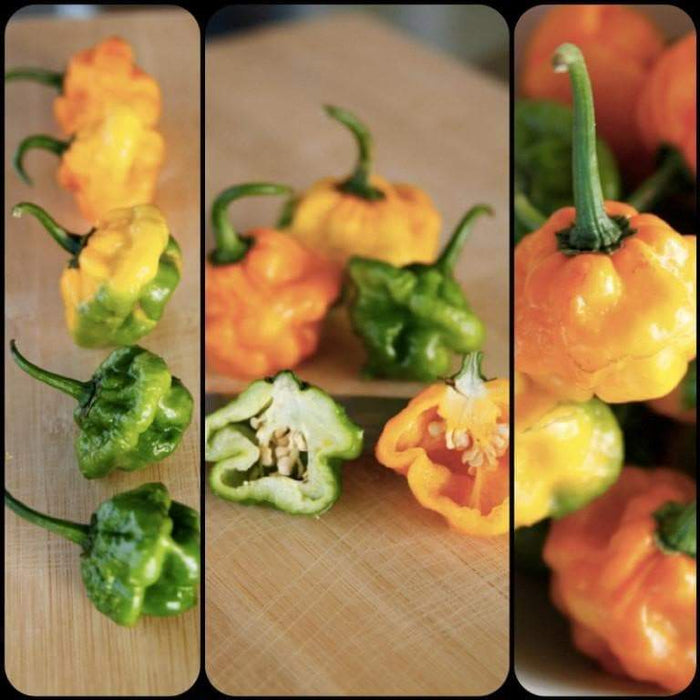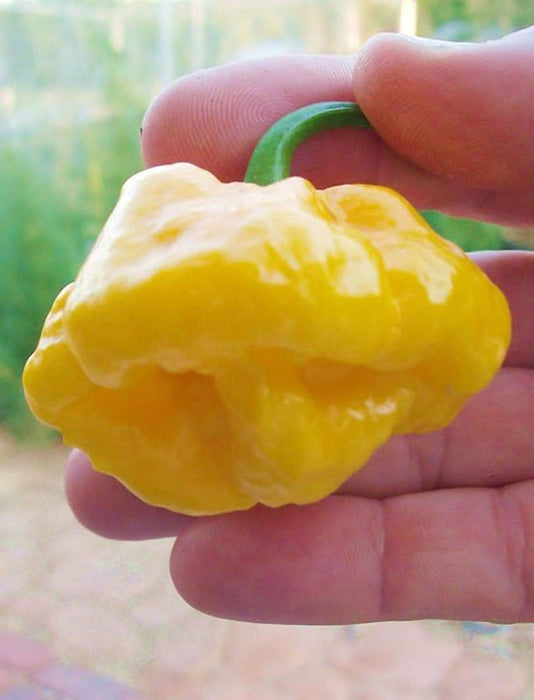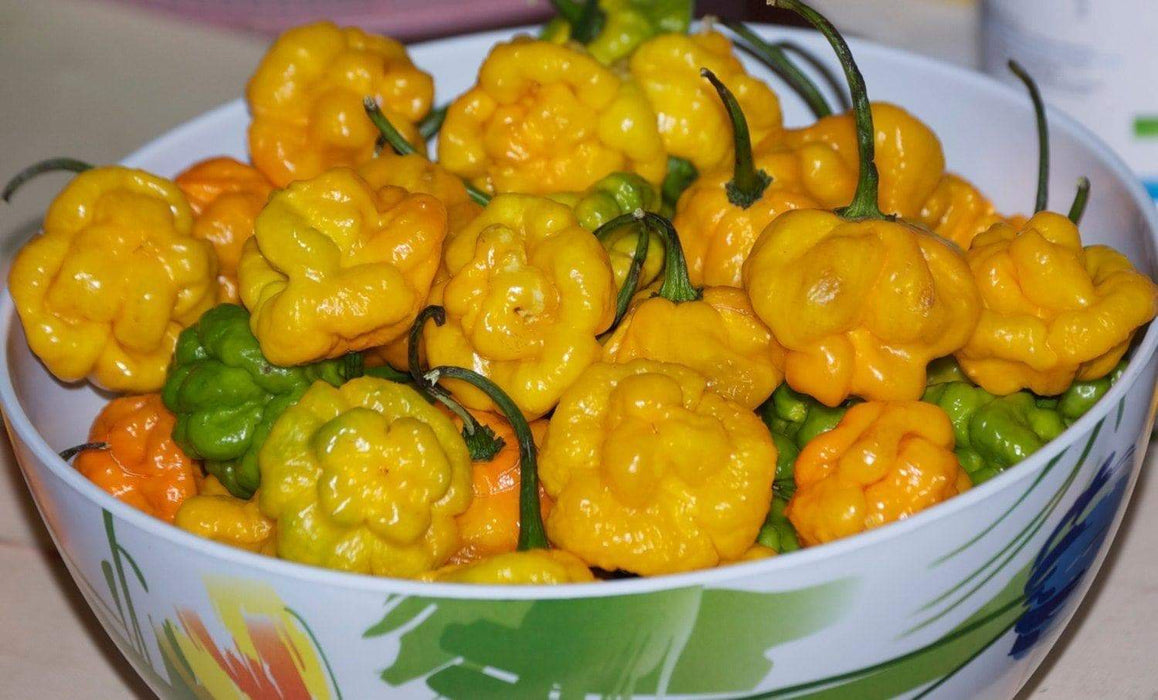
Jamaican Scotch Bonnet PEPPER (Capsicum chinense) Pepper seeds
Most orders are processed by the next day
Select your desired size and/or color from the available options.
Authentic Jamaican Scotch Bonnet Pepper seed (Capsicum chinense),Frequently Confused with Habanero, Definitely not the same !
THESE SEEDS ARE FROM MY NATIVE ISLAND OF JAMAICA !
Real Scotch Bonnet ,,Frequently Confused with Habanero,Definitely not the same"Large and very well flavored Bonnets, growing on strong plants.TFM means ""true form""
This is a real Scotch Bonnet “NOT” Yellow or Orange Habanero that others try and pass off as Scotch Bonnet.
Jamaica is almost as famous for its fiery Scotch bonnet peppers (which are rated as hotter than most habaneros) as it is for Reggae music and sports. Rarely will you find a Jamaican cooking without some of this pepper. Most often used on jerk chicken or pork, peppered shrimp, peppered steak and patties (a meat-filled pie), Scotch bonnet is the pepper of choice among Caribbean nationals. But for most visitors, especially those unfamiliar with this pungent chile, the strength of the Scotch bonnet is a shock.
Scotch Bonnet Pepper is widely used to season many different dishes and cuisines by Jamaican Chefs and households. Scotch bonnet peppers give Jerk Pork, Jerk Chicken and Jerk Fish their unique flavor.
Jamaican delicacies like curried goat, stews, soups, rice and peas and other everyday meals such as patties (a meat filled pie) and peppered shrimp: are all enhanced by the incredible flavor of Scotch bonnet peppers.
This Is Real Jamaican SCOTCH BONNET "" Pepper Seeds, FROM MY GARDEN! I have Been Growing Scotch Bonnet Pepper For more than 25 years, Back home in Jamaican my Father is one of the largest pepper grower. The seeds that i grow was past down from generation to generation- HEIRLOOM !
MORE DETAILS
The Scotch bonnet's history has been traced to Central and South America; however, there is no concrete proof as to where the chile pepper was first cultivated. Although frequently confused with the habanero, the Scotch bonnet or Jamaican Hot is definitely not the same as its stout cousin. So how do you know a Scotch bonnet pepper?
The mature pepper measures between 1 1/2 and 2 inches in diameter. The color of the immature pepper is green, but the mature Scotch bonnet has an attractive range of colors: bright yellow, orange or red. One of the defining features of this type of pepper is its sweet aroma and unique flavor. In fact, the Scotch bonnet was the first Caribbean hot pepper to be known by a specific name in the export market.
Peppers were commonly used, in the period before refrigeration became commonplace, as an effective preservative for meats. It is this need to preserve the meat of wild Boar that started the preparation of “Jerk Pork” at Boston Bay in Portland, Jamaica. This was a localized dish for decades, and eventually spread across Jamaica in the 1970s and 1980s. Jerk Chicken and Jerk Fish, are relatively recent developments and came with the spread of the ‘Jerk’ phenomena across Jamaica. Now “Jerk” is known all around the world.
Real Jamaican Scotch Bonnet Pepper turns yellow when ripe. When the pepper is turned upside down the shape, resembling the bonnet or headdress worn by Scottish men: thus, the name, Scotch Bonnet. The shape is sometime referred to as “Cup and Saucer.”
There are many other peppers of different shapes and colours in Jamaica, but if they do not have the correct shape and colour, they are not Scotch Bonnet.
These seeds have been germination tested and have been grown organically
HOW TO GROW PEPPER SEEDS
- 1. where gloves
- 2.always wash your hands even after you take you gloves off
- 3.have some lime juice to dump on your hands if they are burning as its said to releave the burning
- 4.never rub any sensitive area like your eyes and so forth.
- 5.before you take your gloves off besure you are completely finished at what you are doing
- 6.some times double up on your gloves as the burn can still find its way in at times
Instruction
Sow seeds indoors ¼" deep. Peppers germinate best in warm soil, so gentle bottom heat may be helpful until seedlings emerge. Wait to transplant outdoors until soil is warm.
Pepper varieties come from tropical humid regions. The temperature, moisture, and air circulation all play a role in growing plants from seeds. Too little heat, too much moisture, and lack of air circulation will cause poor results. Do not use jiffy peat pots, plugs, or potting soil as the soil becomes too dry or too wet, which can lead to disease and fungus. We have experienced disease and low germination when using these types of products. Use Organic Seed Starting Material for best germination results.
Peppers often like to take their sweet time germinating. They can be up in a week, and some will take almost a month. Even with paper towel germination testing, they can take long. I am not sure why, but it is a normal occurrence. So plan and make sure you start them early enough! Also, remember they like heat to germinate so make sure you have a heating mat or something to keep the soil warm. Placing them up on top of the fridge often works too since it is normally warmer up there.
Growing Peppers:
Peppers, like tomatoes, grow in well-drained fertile soil. Almost all peppers have the same requirements for successful growth. Plant them in good, well-drained, fertile soil – and make sure they get lots of sunlight and a good inch of water per week. In many ways, they mimic the same requirements needed for growing great tomatoes.
At Planting Time:
We plant all of our peppers with a good shovel full of compost in the planting hole, and then give them a good dose of compost tea every few weeks for the first 6 weeks of growth. We also mulch around each of our pepper plants with a good 1 to 2″ thick layer of compost.
Growing Hot Peppers in Containers
Peppers can be grown all year long in containers. It is suitable for apartment dwellers and gardeners who live in cool regions where the number of growing days are limited. Many pepper enthusiast grow peppers in pots so they can have fresh peppers all year long. It’s best to use 5 gallon containers so the roots do not get too over-crowded
LET OUR CUSTOMER SPEAK FOR US

![[Seeds] - Caribbeangardenseed](http://caribbeangardenseed.com/cdn/shop/files/gift-card-gift-card-1_1024x1024_dfa857db-9150-4315-a362-7f0bb3fb9c47_60x28.png?v=1703978838)



